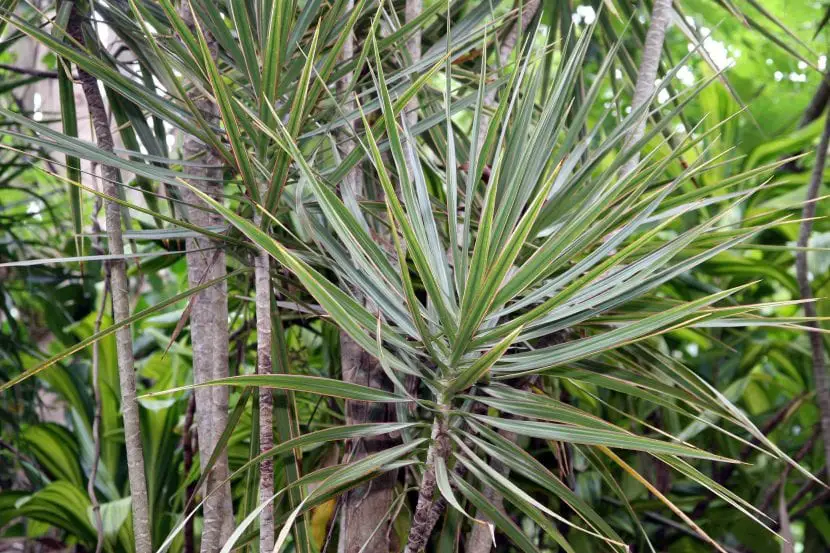
Image – Wikimedia Commons / David J. Stang
It is one of the most common plants in nurseries, and no wonder: its beauty and easy cultivation make it a very interesting species to grow both inside and, if the climate is warm, outside. We are talking of course about the Dracaena marginataa shrub-tree with bicolor leaves that we like so much.
It has a rather slow growth rate, but that more than a drawback is a reason for joy since it means that its development can be better controlled. Know all its secrets.
Origin and characteristics

Image – Wikimedia Commons / David J. Stang
Our protagonist is a shrub or tree that usually grows up to 5 metersbut that in habitat and in warm tropical climates it can exceed them and reach 10m. Its scientific name is Dracaena marginata o Dracaena reflexa var. angustifoliaand is known by the common names dracena, dracena marginata, or fine-leaved dracaena.
It can have one or more logs whose thickness does not exceed 40cm in diameter. The leaves are linear to lanceolate, 30-90cm long by 2-7cm wide.with a dark red margin. There is a variety, ‘Pink’, which is more pinkish-orange.
What are their cares?
If you want to have a copy, we recommend you take care of it as follows:
Location
- Outdoor: it is a plant that needs protection from the sun, especially during its youth. Ideally, it should be placed in a semi-shaded area and that, as it gains height, it becomes accustomed to the light.
- Interior: it is important that it is placed in a room where a lot of natural light enters, but beware: do not place it right in front of the window as it will burn.
Earth
- the garden: prefers sandy soils, with very good drainage.
- Flower pot: advisable to put a first layer of pumice (you can get it here!), arlita (for sale here!) or similar.
Irrigation

Image – Flickr / Forest & Kim Starr
The Dracaena marginata it is a plant that resists drought, but not too much. In addition, they are harmed by waterlogging. Therefore, to avoid problems, apart from planting it in well-drained soil, It is highly recommended that before watering it check the humidity of the same. How do you do that? Very easy:
- Using a digital moisture meter: when you put it in the ground it will tell you if it is dry or not.
- Introducing a thin wooden stick: if when you extract it, it comes out with a lot of adhering soil, do not water.
- Weighing the pot once it is watered and again after a few days: wet soil weighs more than dry soil. By noticing this difference in weight, you will know when to water and when not to.
Apart from this, you have to keep in mind that you cannot wet the leaves or the trunk when you water. The rains will not affect you, as long as they are not very followed, since they usually fall on cloudy days; but if you wet the leaves they can burn with the sun.
Subscriber
From mid spring to early fall you can pay it with Organic fertilizers such as guano, which is rich in iron. You can get it in nurseries, but also here! in liquid form (ideal for pots) and here! powder (for garden).
Multiplication
The Dracaena marginata multiplies by seeds and cuttings in spring. Let’s see how to proceed in each case:
Seeds
- The first thing you have to do is fill a 10,5cm diameter pot with universal growing medium mixed with perlite in equal parts.
- Then, water thoroughly and place a maximum of two seeds in the pot.
- Then cover them with a thin layer of substrate and water again, this time with a sprayer.
- Finally, place the pot outside, in semi-shade.
Thus, they will germinate in a maximum of 2 or 3 weeks.
Cuttings
To multiply it by cuttings you have to cut a piece of mature-woody branch about 30-35cm long, impregnate the base with homemade rooting agents and plant it in a pot with vermiculite, in a place protected from the sun.
Pruning

Image – Wikimedia Commons / Forest & Kim Starr
It’s not necesary. You just have to remove the branches that are dry, sick, weak or broken at the end of winter, as well as – if you get to them 🙂 – the withered flowers.
Planting or transplanting time
In springwhen the risk of frost has passed. If you have it in a pot, transplant as soon as you see that roots grow out of the drainage holes or every 2-3 years.
Plagues and diseases
It can be affected by red spiders y mealybugs, which are eliminated with specific insecticides or simply by cleaning the leaves with water and neutral soap.
In very humid environments, also fungi that rot the roots and / or the rest of the plant. They are fought with fungicides, but it is best to prevent by controlling the risks.
Problems
The problems you may have are:
- Withered leaves: it is due to excess water. Reduces the frequency of irrigation.
- Lower leaves yellow: It is normal. As they age, they turn yellow first and brown later.
- Brown leaves, sad looking plant: the environment is too humid. Reduce the risks and do not spray.
- Leaves with dry parts: the environment is too dry. Place glasses of water or a humidifier around it.
Rusticity
From experience I can tell you that it copes well with cold and sporadic and short-term frosts of up to -1’5ºCbut yes, only if it is a little sheltered (for example, if it is planted in front of plants that are larger than it, or behind a wall).

Image – Wikimedia Commons / David J. Stang
I hope you enjoy your Dracaena marginata.
